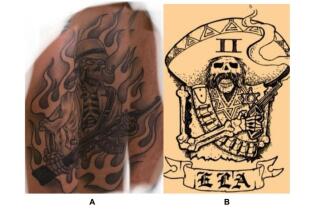Pediatricians may view tattoos, piercings as red flags. They should discuss it instead, report says

- Share via
Tattoos or pierced body parts have long been considered a red flag for pediatricians who found them on their patients. Physicians who came across an inked symbol or a navel ring while examining an adolescent or young adult were taught to probe for other dangerous behaviors, including drug use, weapons carrying, risky sexual activity, and self-injury.
In a flood of ink both literal and figurative, that medical advice has been washed away.
On Monday, the American Academy of Pediatrics issued its first-ever clinical guidelines to members on tattooing, piercing and scarification in adolescents and young adults. It was published in the journal Pediatrics.
Few young patients appear to appreciate all the health risks involved, or to take into account the views of future employers, the guidelines say. And they typically underestimate the difficulty of having tattoos removed if they come to regret them.
But, says the Clinical Report, body modification is quickly becoming commonplace, and the kids who engage in it are more than likely normal, healthy kids expressing themselves in ways that need not raise concerns.
“Tattooing and piercing of various body parts no longer is a high-risk population phenomenon, as evidenced by growing numbers of adults and adolescents not considered at risk who have tattoos and multiple ear and body piercings,” says the new report.
Today, as many as 38% of young people between the ages of 18 and 29 report having a tattoo, and among private college students, navel piercings have been found to be roughly as common.
While piercing of the tongue, nipple or genitals were acknowledged by closer to 1 in 10, these body modifications were hardly rare, either. A 2016 Harris Poll found that most adults who have gotten a tattoo — 86% — have never regretted doing so, and that people who get inked typically say they feel sexier, rebellious, attractive or strong.
There are, to be sure, medical concerns that pediatricians should raise with their patients. Infections, including hepatitis B and C and HIV infections, can happen when piercing and tattoo practitioners fail to use sterile equipment and new ink. Patients who are immunocompromised, or who take medications that suppress immunity should not undergo such procedures.
And then, there’s the attitude of future employers to consider.
The report cites a report by an executive career coach who found that 37% of human resource managers named tattoos as the third physical attribute likely to limit career potential (non-ear piercings and bad breath were the top two).
“Consequently, adolescents and young adults contemplating body modification may be well advised to make sure that the tattoo or piercing is not visible in typical work attire,” the academy report notes.
But physicians must deal in clinical evidence, says Dr. Cora C. Breuner, who headed the committee drafting the new academy guidelines. And those suggest that body modification is no longer a reliable predictor of social deviance, she says.
More often, she says, it’s a generational act of solidarity.
“They’re emulating people who are out there — athletes, musicians, military personnel — people they look up to,” said Breuner. “These aren’t social deviants. With all due respect, when we say, ‘No!’ they say: ‘What? You’re wrong.’”
Breuner said pediatricians should always consider a “careful clinical interview” of the patient’s intentions, designed to ensure there’s no compulsive self-injurious behavior. But where those inquiries fail to raise concerns, a physician should take the opportunity to have a conversation with patients about keeping vaccinations up to date, choosing hygienic tattoo and piercing parlors, and considering the attitudes of future employers.
For some older adolescents and young adults, these will be the first patient-doctor conversations about a matter of true mutual interest, she said. By entrusting the patient to weigh risks and benefits with a doctor’s help, it can be an important step toward adulthood, she said.
“They don’t come to see us a lot as adolescents anyway,” said Breuner. “This provides a lot of opportunity. They can talk to us about tattoos and body piercings, and then we can talk about violence in relationships and sexually transmitted diseases. We can be nonjudgmental and have a dialogue with you as a patient in which we don’t say, ‘because I said so.’”
Breuner initiated the academy’s guidelines after her then-18-year-old daughter came to her to discuss getting her navel pierced. As a member of the Baby Boomer generation, Breuner said she was more likely than some younger physicians to see such a proposal as problematic: At best, she thought, it was the start of a downward slide into poor decisions.
“My first reaction was no, hell no,” she said. But when she went to the academy’s clinical statements for guidance, she found there were none to aid her in helping her daughter make the best decision.
Five years later, her daughter has survived her piercing, her pediatrician colleagues have a resource to turn to, and Breuner says she has a new view of tattoos and body piercings.
“I’ve discovered this is not a form of self-harm,” said Breuner. “It is absolutely a form of body art or body modification.”
Twitter: @LATMelissaHealy







